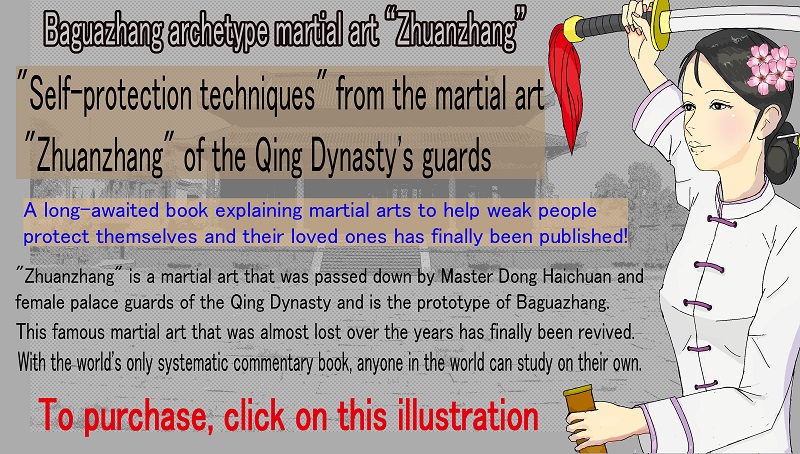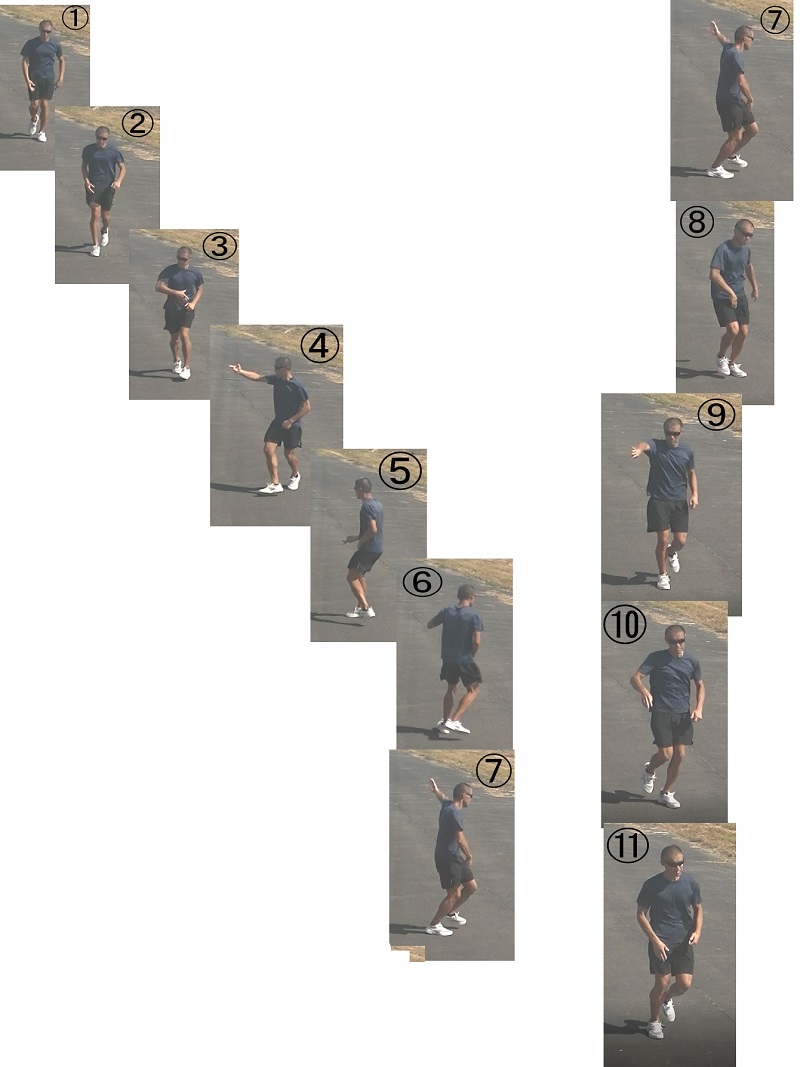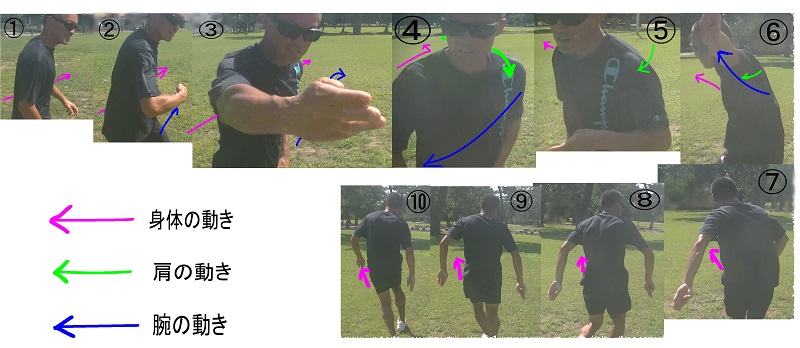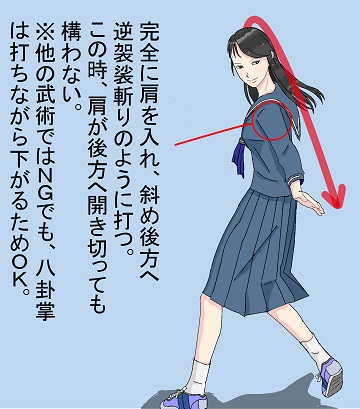This is where the method of dealing with an enemy using "Zhuanzhang" begins.Let's practice using a form for beginners called 'Tuizhang Zhuanzhang S' ,which is a simplified version of "Danhuanzhang", which is the basic bare-handed technique of "Zhuanzhang".
We will understand the theory of combat in "Zhuanzhang", why we use this method, and questions while actually practicing and experiencing the basic kata.In actual combat, you will feel especially strongly that you can only use simple techniques like this when it becomes an endurance battle.
You can also experience the "Danhuanzhang's theory", which is made up of "Fanshenxuan Li" (turning the body) and "Daolibeizou Li" (backward movement of the sword), which are important body manipulation methods in "Zhuanzhang", and this will help you improve as you refine your techniques through repeated practice.
In extreme situations where life and death are at stake, complex techniques are largely impossible to carry out.Instilling simple techniques into your body and moving unconsciously will lead to survival, and by surviving for a certain amount of time, you will be able to protect important people and the people you need to protect.
 Introduction | Explanation of basic techniques for survival against many people, strong opponents, and weapons in "Zhuanzhang" that is intended for use by the weak
Introduction | Explanation of basic techniques for survival against many people, strong opponents, and weapons in "Zhuanzhang" that is intended for use by the weak Learn the movements by practicing the basic form of "Tsuizhang Zhuanzhang Style"
Learn the movements by practicing the basic form of "Tsuizhang Zhuanzhang Style" "Connect to real combat - Be aware of "entering the body" method that allows you to fight against strong people and many people
"Connect to real combat - Be aware of "entering the body" method that allows you to fight against strong people and many people

Introduction | Explanation of basic techniques for survival against many people, strong opponents, and weapons in "Zhuanzhang" that is intended for use by the weak
"Anti-enemy body technique for retreating by sliding diagonally backwards without turning your back on the enemy" allows you to survive for a certain period of time in unfavorable battle situations against many people, strong opponents, and weapons. "Zhuanzhang" used this "survival for a certain period of time" to decoy themselves and attract attackers, and protected the royal family of the Qing dynasty.
"Anti-enemy body technique for retreating by sliding diagonally backwards without turning your back on the enemy" created and composed "Dan Hai chan", the most important basic bare-handed technique of "Zhuanzhang", and later gave rise to many derivative techniques.
It is the secret to dealing with enemies approaching from the rear or side without losing the momentum that comes with your movement. In "Zhuanzhang", maintaining the momentum of movement was so important that it promoted the establishment of this great fundamental.
If your movement speed slows down to deal with the approach and attack of the enemy, you will be caught by another enemy.
If your movement speed slows down to deal with the approach and attack of the enemy, you will not be able to defend yourself by moving, and you will be hit head-on by the attack of a martial artist of general martial arts who is a specialist who stays still and attacks.
If your movement speed slows down to deal with the approach and attack of the enemy, you will not be able to launch a sudden lightning attack, you will no longer be a threat to the enemy, and important people will be attacked by other assailants.
The most dangerous turn is when your movement speed slows down when the enemy approaches, and "Tan Huan Shou" was devised to overcome this dangerous turn. "Dan Huan Shang" became a major technique in "Tan Huan Shang" called "the technique of Tan Huan Shang" and gave birth to many anti-enemy forms.
The "Tsuizhang Zhuanzhang Style" used here to learn "anti-enemy body technique for retreating by sliding diagonally backward without turning your back to the enemy" is a simpler form of Tan Huan Shang. It is used by those who have mastered "Tan Huan Shang", and although it is simple, it is a great ally in self-defense.
Please do not get bored of its simplicity and repeat it many times to master it.
Learn the movements by practicing the basic form of "Tui Zhang Zhuanzhang Style"
We will practice using the "Tui Zhang Zhuanzhang Style" movement, which is simple and easy to perform even for beginners, yet is also relied upon by experienced practitioners.
"Zhang Zhuanzhang Style" is the core technique of "Tenshou" in which, while moving to an area where there are no enemies, you can instantly avoid an enemy approaching from diagonally behind or from the side, without slowing down your speed or momentum.That name became the name of the martial art.
Key points, movements and practice methods
"Tuizhang Zhuanzhang Si" is a representative technique of the diagonal backward slide anti-enemy technique, and is a main technique that simplifies "Danhuanzhang", which is the basic form of the bare-handed technique of "Zhuanzhang".Although it is the first technique taught at Suishikikan, it is a proven technique that is often used later.Many masters of Suishikikan use this technique to avoid crises and troubles.
"Tui Zhang ZuhanZhang Shi" is a typical beginner's kata in which you deal with the enemy in front of your chest, without turning your back to them.The movement is large and the trajectory is relatively straight, making it very easy to practice even for beginners.
Slide diagonally backwards and put your hand out in the direction of the enemy to block the attack path, then quickly put your opposite shoulder in and push out your hand for a check attack while continuing to slide to distance yourself from the enemy.
If you ``walk sideways'' like a crab or ``retreat'' by moving straight backwards, you will lose to the speed of the pursuing enemy and be pushed into the enemy.
While moving diagonally backwards, by maintaining a vector of ``moving forward'' that makes it easy to maintain speed, you can continue running through the enemy without losing much of your momentum.

Learn slow motion by imitating it
While you are moving from turning to moving straight, keep in mind that the enemy is approaching from behind.In actual multiplayer battles, there is no time to turn your head in the direction of the enemy, so even in practice, you do the actions all at once without including the awareness or action of turning your head.
If you imagine that the enemy is rapidly closing the distance between you, move diagonally backwards, extend your hand, and then quickly thrust the blade of your hand toward the enemy while putting your shoulder in.This pushing action is called "Tui".
At the same time as you hold out your hand, change the direction of movement diagonally and begin moving on the arc on the opposite side of the previous turn.In actual combat, you would immediately convert a turn into a straight line of movement.When practicing the basic form, you continue to move in circles, including practicing rotation, and then from that position you again move into the ``Tuizhang Zhuanzhang Si' movement.
Connect more to actual combat~Learn the "Rushenfa" technique that will give you a chance to survive in battles against strong opponents or against multiple opponents.
After learning the basic movements, practice with an eye to points that are directly connected to actual combat, such as exchanging and blocking enemy charges.The key point is the "Rushenfa".
Of all the exercises, including the "interpersonal practice" that we will do later, I would like you to focus most on this one.
The biggest advantage is that you can practice as much as you like by yourself, as long as you can visualize the approaching enemy.After a large number of repetitions, even people in environments where interpersonal practice is not possible will be able to unconsciously take evasive action in the event of an emergency.
Detailed explanation of the "Rushenfa" movements
Action 1: Hold out your hand in response to enemy attack
If you imagine the enemy closing the distance all at once, move diagonally backwards and hold out your hand.You can simply hold out your hand, but at this time, do not put your body into it, put your hand out, and as you slide it out, gradually insert your body. There is no need to try to hit the enemy's attacking hand with this move.
If a beginner puts his/her body into the move, his/her slide technique is still immature and he/she cannot make a flowing movement, so his/her body will face directly towards the enemy and in that state, he/she will receive the force of the enemy's attack. This will result in a situation where you will get stuck.If you are facing directly in front of you and an enemy lunges forward violently, you will receive the force vector of the enemy's lunge and be pushed into the enemy.
If you don't put your body in, even if the enemy rushes forward and pushes you in after you make a move and you can't make the next move, which is to put your shoulder in, you can just slide diagonally backwards to dodge.Although you cannot attack, you can firmly accomplish the purpose of ``protecting yourself'' by shifting the vector of the enemy's attack away from you.Imagine coping like a bullfighter.
A master of "Zhuanzhang" will continue the sliding movement even if he simply extends his hand without getting his body in, and his body will naturally move in as he continues the smooth slide.If the enemy's pressure is strong when he puts out his hand, he will just let his body escape, and if it is not strong, he will continue with a diagonal backward slide. This is the decision that masters of "Zhuanzhang" make in an instant and unconsciously.
It's important to reiterate that Stretching out your hand does not mean attacking the enemy.There is no problem even if the hand you put out does not hit the enemy's attacking hand or the enemy's body.In fact, the state of ``hitting'' means being close to the enemy, which is not desirable, and the desire to ``hit'' causes one's body to move closer to the enemy, creating danger.
Action 2: Deterrence Attack
Regardless of whether the hand you put out hits the enemy or not, you will move on to the next action.
While pulling back the hand you put out in the action of holding out your hand, you continue to slide diagonally backwards and enter into the next action, 'fake Attack and Deterrence Attack'.
Facing the enemy with your shoulders in front, you switch shoulders, and the moment you complete the switch, extend your hand toward the enemy as if twisting it into a check attack.Your body will have completed the entry and your shoulders will be fully open.

Why is the "Rushenfa" performed?
This body technique is the key point (secret technique) of 'Rushenfa' that was established at the time of the establishment of 'Zhuanzhang' which makes it possible to fight against strong opponents and large groups of people.This is a unique requirement of 'Zhuanzhang', which involves mobile combat against a large number of people, and is an important secret that supports that strategy at the foundation level.
By letting your shoulders lead and then putting your hand out the moment your shoulders are fully engaged, you can attack while moving your body backwards.In other words, the action of "moving your hand toward the enemy diagonally behind you as you put your shoulders in" is also the action of starting to slide diagonally backwards to avoid it.
When you perform this movement, your shoulder, which is the starting point of your outstretched hand, will be in a fully open state.In other martial arts, this state is an undesirable movement that should be avoided, but in 'Zhuanzhang', it is a movement that should be desired.

'Zhuanzhang' is a martial art that focuses on countermeasures by diagonally backward sliding, which is best to avoid colliding with the strength of a strong person, so even if it is a restraining attack, it requires a striking method that does not clog the distance.
The way to strike to achieve this is to hit the opponent in conjunction with the movement of the shoulders.When you hit with your shoulder engaged, a vector of force acts on your body in the opposite direction to your opponent.Using that force vector, you can strike while leaving.
By executing "Leaving while striking", you can block the enemy's attack by placing your shoulder and hand in the path of the attack from the enemy to you. /strong>That will happen. This plays a "defensive" role
In other words, you can prevent the enemy's attack from hitting your body by using two defensive measures: "putting your thrusted shoulder and hand in the path of the enemy's attack" and "sliding diagonally backwards while thrusting" to move away from the enemy.These two defenses allow you to easily move quickly from one location to another, helping you hold out and survive until you have a chance to retreat.
Disclaimer
This website is not responsible for any actions taken by users using the information posted on the website.
The explanations of theory and other aspects on this website are based on what the administrator has learned through his studies and training, and the content does not deny the theories of other schools.
Currently, many renowned and highly skilled teachers of many schools are providing instruction both in Japan and overseas. We would be happy if you would use the content of this website as a way of thinking.
